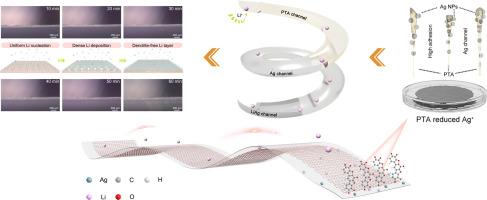紫外光辅助下聚单宁酸-银层的快速聚合用于设计无阳极锂金属电池中的亲锂层
IF 20.2
1区 材料科学
Q1 CHEMISTRY, PHYSICAL
引用次数: 0
摘要
无阳极锂金属电池(aflmb)通过使用裸铜(Cu)箔作为阳极来提高能量密度。然而,由于材料固有的疏锂性导致不可逆的锂(Li)电镀,它们面临着挑战。在这项研究中,我们提出了一种紫外辅助原位聚合策略,在短短15分钟内创建了嵌入银纳米球(PTA@Ag-Cu)的聚单宁酸膜。PTA膜提高了电解质的润湿性,降低了50.6%的接触角,加速了Li+的脱溶。通过形成亲锂LiAg合金,银纳米颗粒(21 nm)将成核过电位降低到10 mV,而裸Cu则为150 mV。原位光学显微镜证实了密度泛函理论(DFT)验证的电荷传递动力学和嵌入电场有助于Li的均匀沉积。飞行时间二次离子质谱分析(TOF-SIMS)表明,在原子水平上,Ag和PTA分子水平的相互作用对Li+通量有协同调节作用。PTA@Ag-Cu||LiFePO4配置在没有预锂化的情况下,以1 C-rate的速率进行100次循环后,容量保持率达到61.2%。采用紫外光辅助聚合法制备PTA@Ag-Cu经济、省时,适合规模化生产。这项工作引入了一种光致双功能接口,通过集成电场工程解决AFLMB降解问题,使其与卷对卷电池制造兼容。本文章由计算机程序翻译,如有差异,请以英文原文为准。

UV-Assisted Rapid Polymerization of Poly(Tannic Acid)-Silver Layers for Design Lithiophilic Layers in Anode-Free Lithium Metal Batteries
Anode-free lithium metal batteries (AFLMBs) enhance energy density by using bare copper (Cu) foils as the anode. However, they face challenges due to irreversible lithium (Li) plating caused by the inherent lithiophobicity of the materials. In this study, we present an ultraviolet-assisted in-situ polymerization strategy to create a poly(tannic acid) film embedded with silver (Ag) nanospheres (PTA@Ag-Cu) in just 15 minutes. The PTA film improves the wettability of the electrolyte, reducing the contact angle by 50.6%, and accelerates Li+ desolvation. The Ag nanoparticles (21 nm) lower the nucleation overpotential to 10 mV compared to 150 mV for bare Cu, through the formation of a lithiophilic LiAg alloy. The charge-transfer dynamics and embedded electric fields, which are verified by density functional theory (DFT), contribute to the uniform deposition of Li, as evidenced by in situ optical microscopy. Time-of-flight secondary ion mass spectrometry (TOF-SIMS) indicates a synergistic regulation of Li+ flux at the atomic level by the combination of Ag and molecular-level interactions from PTA. The PTA@Ag-Cu||LiFePO4 configuration achieves 61.2% capacity retention after 100 cycles at a rate of 1 C-rate without pre-lithiation. The preparation of PTA@Ag-Cu using UV-assisted polymerization is economical, time-saving, and suitable for large-scale production. This work introduces a photo-induced dual-functional interface that addresses AFLMB degradation through integrated electric field engineering, making it compatible with roll-to-roll battery manufacturing.
求助全文
通过发布文献求助,成功后即可免费获取论文全文。
去求助
来源期刊

Energy Storage Materials
Materials Science-General Materials Science
CiteScore
33.00
自引率
5.90%
发文量
652
审稿时长
27 days
期刊介绍:
Energy Storage Materials is a global interdisciplinary journal dedicated to sharing scientific and technological advancements in materials and devices for advanced energy storage and related energy conversion, such as in metal-O2 batteries. The journal features comprehensive research articles, including full papers and short communications, as well as authoritative feature articles and reviews by leading experts in the field.
Energy Storage Materials covers a wide range of topics, including the synthesis, fabrication, structure, properties, performance, and technological applications of energy storage materials. Additionally, the journal explores strategies, policies, and developments in the field of energy storage materials and devices for sustainable energy.
Published papers are selected based on their scientific and technological significance, their ability to provide valuable new knowledge, and their relevance to the international research community.
 求助内容:
求助内容: 应助结果提醒方式:
应助结果提醒方式:


